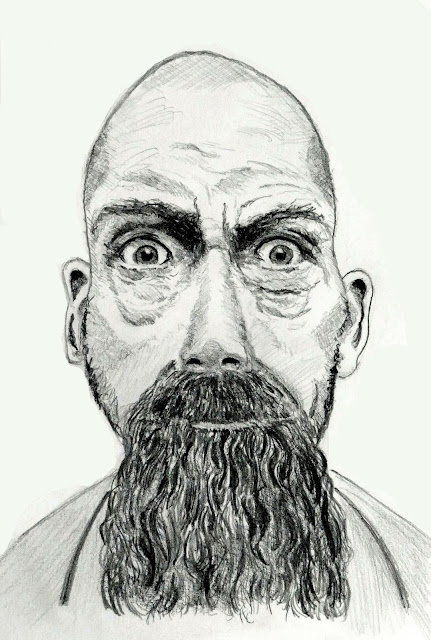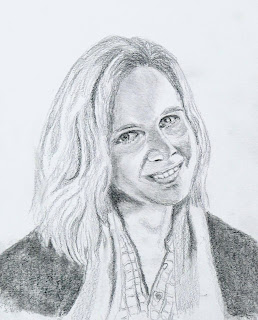Welcome on this Easter Sunday morning to people of faith, people of no faith and all those in between. I'd just like to write briefly about one episode from the Gospel of Mark with a short explanation of why it means so much to me.
There have been many great paintings of the story of the Road to Emmaus (the story follows below) but I particularly like this one by Michael Torevell because it is so fresh and descriptive.
There have been many great paintings of the story of the Road to Emmaus (the story follows below) but I particularly like this one by Michael Torevell because it is so fresh and descriptive.
I like the way that the second disciple who is not named in the story is depicted as a woman (OK, so it was probably two men, but the original language does not say that specifically). I also like that the artist has left the crosses prominent in the painting because despite everything that has happened since, the cross will always be the defining image of the Christsian faith. I just love this painting - you can even buy a copy of it at Fine Art America - https://fineartamerica.com/featured/road-to-emmaus-michael-torevell.html. I regret that I have not had time to get permission to post Michael’s painting here but at least I can promote his work in return and if he contacts me to complain I will immediately take it down.
Let's just recap the story. On that first Easter Day, two of Jesus’s disciples are leaving Jerusalem feeling perplexed and disappointed. They had expected Jesus of Nazareth to liberate Israel from Roman rule (wasn’t that always what the Messiah was supposed to do?) and instead of that the Jewish rulers had handed him over to the Romans to be crucified. And now, three days after that dreadful event, some women followers claimed that the tomb was empty and that they had actually seen Jesus alive!
As they walked together on their way to an outlying village, a stranger had joined them on their journey. They had no idea who he was but as they walked he began to explain to them that of course the Messiah had to suffer and die - after all, hadn’t Jesus tried to tell them that all along? Anyway, the day was drawing to a close and they turned aside to an inn to get a meal and some rest. The stranger went as though he was going to travel on but they urged him to join them in the inn as it was now evening. When the meal was served, the mysterious man took the bread and blessed it and broke it and suddenly “their eyes were opened” and they recognised that it had been Jesus all along. They said, "of course, didn’t our hearts burn within us while he talked to us on the road?" Jesus vanished from their sight and the two disciples got up and returned to Jerusalem to hear that yes, Jesus was being seen by more and more of his followers.
If you want to you can read the full version here. I can say that this is a story which has beguiled me for many years. It has a sort of “ring of truth” about it, the haphazard way it happens, the randomness of just these two people (only one of them is significant enough to be named) and the way that their sudden understanding of who it was who sat with them happened in the breaking of bread - such a typical action of their Master. But more than that, as a regular walker in hills and quiet country, this is an experience I have known frequently myself. My good friend John from Guildford and myself have had many walks where we have started out just chatting and before long we find ourselves turning to a parable or some event in the life of Christ and finding ourselves engrossed and heart-warmed as we explore what these things mean to us. John and I have walked on Welsh mountains and on rural country paths and wherever we are that mysterious stranger has drawn alongside us made us glad to be with him. it happens on my own too. I am not good at prayer - the keeping lists of who I should remember and the working through them is not something I am good at, but once I’ve left bus, train or car and head off into the hills on a solitary walk I find myself not alone but with am unexpected companion who begins to remind me of people and things he wants to talk to me about.
Many, many followers of Jesus have this experience. Some years ago there was a TV series in which the late Malcom Muggeridge explored the Holy Land with historian Alex Vidler and he described how, “we too were joined by a third presence, and I tell you, wherever the walk, whoever the wayfarers, there is always this third presence ready to emerge from the shadows and fall into step along the dusty, stony way”. I love paintings of people walking - here is one I did myself of two women out for a walk on the hills of Sussex near Alfriston which I've called "Friendship".
As they walked together on their way to an outlying village, a stranger had joined them on their journey. They had no idea who he was but as they walked he began to explain to them that of course the Messiah had to suffer and die - after all, hadn’t Jesus tried to tell them that all along? Anyway, the day was drawing to a close and they turned aside to an inn to get a meal and some rest. The stranger went as though he was going to travel on but they urged him to join them in the inn as it was now evening. When the meal was served, the mysterious man took the bread and blessed it and broke it and suddenly “their eyes were opened” and they recognised that it had been Jesus all along. They said, "of course, didn’t our hearts burn within us while he talked to us on the road?" Jesus vanished from their sight and the two disciples got up and returned to Jerusalem to hear that yes, Jesus was being seen by more and more of his followers.
If you want to you can read the full version here. I can say that this is a story which has beguiled me for many years. It has a sort of “ring of truth” about it, the haphazard way it happens, the randomness of just these two people (only one of them is significant enough to be named) and the way that their sudden understanding of who it was who sat with them happened in the breaking of bread - such a typical action of their Master. But more than that, as a regular walker in hills and quiet country, this is an experience I have known frequently myself. My good friend John from Guildford and myself have had many walks where we have started out just chatting and before long we find ourselves turning to a parable or some event in the life of Christ and finding ourselves engrossed and heart-warmed as we explore what these things mean to us. John and I have walked on Welsh mountains and on rural country paths and wherever we are that mysterious stranger has drawn alongside us made us glad to be with him. it happens on my own too. I am not good at prayer - the keeping lists of who I should remember and the working through them is not something I am good at, but once I’ve left bus, train or car and head off into the hills on a solitary walk I find myself not alone but with am unexpected companion who begins to remind me of people and things he wants to talk to me about.
Many, many followers of Jesus have this experience. Some years ago there was a TV series in which the late Malcom Muggeridge explored the Holy Land with historian Alex Vidler and he described how, “we too were joined by a third presence, and I tell you, wherever the walk, whoever the wayfarers, there is always this third presence ready to emerge from the shadows and fall into step along the dusty, stony way”. I love paintings of people walking - here is one I did myself of two women out for a walk on the hills of Sussex near Alfriston which I've called "Friendship".























